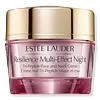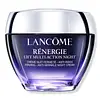What's inside
What's inside
 Key Ingredients
Key Ingredients

 Benefits
Benefits

 Concerns
Concerns

 Ingredients Side-by-side
Ingredients Side-by-side

Water
Skin ConditioningCaprylic/Capric/Myristic/Stearic Triglyceride
EmollientPetrolatum
EmollientHexyldecyl Stearate
EmollientButylene Glycol
HumectantDimethicone
EmollientGlycereth-26
HumectantPEG-100 Stearate
Cetearyl Alcohol
EmollientGlyceryl Stearate
EmollientPropanediol
SolventNarcissus Tazetta Bulb Extract
AstringentCucumis Sativus Fruit Extract
EmollientMimosa Tenuiflora Bark Extract
Skin ProtectingHordeum Vulgare Extract
EmollientCucumis Melo Fruit Extract
Skin ConditioningPersea Gratissima Oil
Skin ConditioningLactis Proteinum
Skin ConditioningCaffeine
Skin ConditioningThermus Thermophillus Ferment
Skin ConditioningAlgae Extract
EmollientLaminaria Digitata Extract
Skin ProtectingArtemia Extract
Skin ConditioningAcetyl Hexapeptide-8
HumectantPolygonum Cuspidatum Root Extract
AntioxidantErgothioneine
AntioxidantTrifluoroacetyl Tripeptide-2
Skin ConditioningTrehalose
HumectantSorbitol
HumectantGlycerin
HumectantDecarboxy Carnosine Hcl
Skin ConditioningCholesterol
EmollientIsohexadecane
EmollientAcetyl Glucosamine
Skin ConditioningMyristyl Myristate
EmollientCetearyl Glucoside
EmulsifyingTetradecyl Aminobutyroylvalylaminobutyric Urea Trifluoroacetate
Skin ConditioningPropylene Glycol Dicaprylate
EmollientAminopropyl Ascorbyl Phosphate
AntioxidantCaprylyl Glycol
EmollientAcrylates/C10-30 Alkyl Acrylate Crosspolymer
Emulsion StabilisingCaprylic/Capric Triglyceride
MaskingTocopheryl Acetate
AntioxidantLinoleic Acid
CleansingPolysorbate 80
EmulsifyingYeast Extract
Skin ConditioningPropylene Glycol Dicaprate
EmollientZinc PCA
HumectantHelianthus Annuus Seedcake
AbrasiveHexylene Glycol
EmulsifyingAcrylamide/Sodium Acryloyldimethyltaurate Copolymer
Emulsion StabilisingSodium Hyaluronate
HumectantMyristyl Alcohol
EmollientTromethamine
BufferingStearic Acid
CleansingPotassium Sulfate
Pentaerythrityl Tetra-Di-T-Butyl Hydroxyhydrocinnamate
AntioxidantCitric Acid
BufferingMaltodextrin
AbsorbentAluminum Hydroxide
EmollientParfum
MaskingPotassium Sorbate
PreservativeDextran
Disodium EDTA
BHT
AntioxidantPhenoxyethanol
PreservativeCI 42090
Cosmetic ColorantCI 17200
Cosmetic ColorantCI 77891
Cosmetic ColorantWater, Caprylic/Capric/Myristic/Stearic Triglyceride, Petrolatum, Hexyldecyl Stearate, Butylene Glycol, Dimethicone, Glycereth-26, PEG-100 Stearate, Cetearyl Alcohol, Glyceryl Stearate, Propanediol, Narcissus Tazetta Bulb Extract, Cucumis Sativus Fruit Extract, Mimosa Tenuiflora Bark Extract, Hordeum Vulgare Extract, Cucumis Melo Fruit Extract, Persea Gratissima Oil, Lactis Proteinum, Caffeine, Thermus Thermophillus Ferment, Algae Extract, Laminaria Digitata Extract, Artemia Extract, Acetyl Hexapeptide-8, Polygonum Cuspidatum Root Extract, Ergothioneine, Trifluoroacetyl Tripeptide-2, Trehalose, Sorbitol, Glycerin, Decarboxy Carnosine Hcl, Cholesterol, Isohexadecane, Acetyl Glucosamine, Myristyl Myristate, Cetearyl Glucoside, Tetradecyl Aminobutyroylvalylaminobutyric Urea Trifluoroacetate, Propylene Glycol Dicaprylate, Aminopropyl Ascorbyl Phosphate, Caprylyl Glycol, Acrylates/C10-30 Alkyl Acrylate Crosspolymer, Caprylic/Capric Triglyceride, Tocopheryl Acetate, Linoleic Acid, Polysorbate 80, Yeast Extract, Propylene Glycol Dicaprate, Zinc PCA, Helianthus Annuus Seedcake, Hexylene Glycol, Acrylamide/Sodium Acryloyldimethyltaurate Copolymer, Sodium Hyaluronate, Myristyl Alcohol, Tromethamine, Stearic Acid, Potassium Sulfate, Pentaerythrityl Tetra-Di-T-Butyl Hydroxyhydrocinnamate, Citric Acid, Maltodextrin, Aluminum Hydroxide, Parfum, Potassium Sorbate, Dextran, Disodium EDTA, BHT, Phenoxyethanol, CI 42090, CI 17200, CI 77891
Water
Skin ConditioningGlycerin
HumectantPrunus Armeniaca Kernel Oil
MaskingCaprylic/Capric Triglyceride
MaskingPentaerythrityl Tetraethylhexanoate
EmollientCetyl Alcohol
EmollientZea Mays Starch
AbsorbentButyrospermum Parkii Butter
Skin ConditioningAlcohol Denat.
AntimicrobialPetrolatum
EmollientPentylene Glycol
Skin ConditioningGlyceryl Stearate
EmollientDimethicone
EmollientPEG-40 Stearate
EmulsifyingCera Alba
EmollientHydroxyethylpiperazine Ethane Sulfonic Acid
BufferingCI 14700
Cosmetic ColorantCI 19140
Cosmetic ColorantSaccharomyces/Xylinum/Black Tea Ferment
Skin ConditioningHydrolyzed Linseed Extract
Skin ConditioningHydrolyzed Soy Protein
HumectantHydrolyzed Hyaluronic Acid
HumectantSodium Hydroxide
BufferingSodium Benzoate
MaskingPhenoxyethanol
PreservativeAdenosine
Skin ConditioningStearyl Alcohol
EmollientAcetyl Tetrapeptide-9
Skin ConditioningPoloxamer 338
EmulsifyingDimethiconol
EmollientLimonene
PerfumingXanthan Gum
EmulsifyingPentaerythrityl Tetra-Di-T-Butyl Hydroxyhydrocinnamate
AntioxidantBenzyl Alcohol
PerfumingCaprylyl Glycol
EmollientAlpha-Isomethyl Ionone
PerfumingSorbitan Tristearate
EmulsifyingMyristyl Alcohol
EmollientGeraniol
PerfumingHexyl Cinnamal
PerfumingParfum
MaskingWater, Glycerin, Prunus Armeniaca Kernel Oil, Caprylic/Capric Triglyceride, Pentaerythrityl Tetraethylhexanoate, Cetyl Alcohol, Zea Mays Starch, Butyrospermum Parkii Butter, Alcohol Denat., Petrolatum, Pentylene Glycol, Glyceryl Stearate, Dimethicone, PEG-40 Stearate, Cera Alba, Hydroxyethylpiperazine Ethane Sulfonic Acid, CI 14700, CI 19140, Saccharomyces/Xylinum/Black Tea Ferment, Hydrolyzed Linseed Extract, Hydrolyzed Soy Protein, Hydrolyzed Hyaluronic Acid, Sodium Hydroxide, Sodium Benzoate, Phenoxyethanol, Adenosine, Stearyl Alcohol, Acetyl Tetrapeptide-9, Poloxamer 338, Dimethiconol, Limonene, Xanthan Gum, Pentaerythrityl Tetra-Di-T-Butyl Hydroxyhydrocinnamate, Benzyl Alcohol, Caprylyl Glycol, Alpha-Isomethyl Ionone, Sorbitan Tristearate, Myristyl Alcohol, Geraniol, Hexyl Cinnamal, Parfum
Ingredients Explained
These ingredients are found in both products.
Ingredients higher up in an ingredient list are typically present in a larger amount.
This ingredient is an emollient, solvent, and texture enhancer. It is considered a skin-softener by helping the skin prevent moisture loss.
It helps thicken a product's formula and makes it easier to spread by dissolving clumping compounds.
Caprylic Triglyceride is made by combining glycerin with coconut oil, forming a clear liquid.
While there is an assumption Caprylic Triglyceride can clog pores due to it being derived from coconut oil, there is no research supporting this.
Learn more about Caprylic/Capric TriglycerideCaprylyl Glycol is a humectant and emollient, meaning it attracts and preserves moisture.
It is a common ingredient in many products, especially those designed to hydrate skin. The primary benefits are retaining moisture, skin softening, and promoting a healthy skin barrier.
Though Caprylyl Glycol is an alcohol derived from fatty acids, it is not the kind that can dry out skin.
This ingredient is also used as a preservative to extend the life of products. It has slight antimicrobial properties.
Learn more about Caprylyl GlycolDimethicone is a type of synthetic silicone created from natural materials such as quartz.
What it does:
Dimethicone comes in different viscosities:
Depending on the viscosity, dimethicone has different properties.
Ingredients lists don't always show which type is used, so we recommend reaching out to the brand if you have questions about the viscosity.
This ingredient is unlikely to cause irritation because it does not get absorbed into skin. However, people with silicone allergies should be careful about using this ingredient.
Note: Dimethicone may contribute to pilling. This is because it is not oil or water soluble, so pilling may occur when layered with products. When mixed with heavy oils in a formula, the outcome is also quite greasy.
Learn more about DimethiconeGlycerin is already naturally found in your skin. It helps moisturize and protect your skin.
A study from 2016 found glycerin to be more effective as a humectant than AHAs and hyaluronic acid.
As a humectant, it helps the skin stay hydrated by pulling moisture to your skin. The low molecular weight of glycerin allows it to pull moisture into the deeper layers of your skin.
Hydrated skin improves your skin barrier; Your skin barrier helps protect against irritants and bacteria.
Glycerin has also been found to have antimicrobial and antiviral properties. Due to these properties, glycerin is often used in wound and burn treatments.
In cosmetics, glycerin is usually derived from plants such as soybean or palm. However, it can also be sourced from animals, such as tallow or animal fat.
This ingredient is organic, colorless, odorless, and non-toxic.
Glycerin is the name for this ingredient in American English. British English uses Glycerol/Glycerine.
Learn more about GlycerinGlyceryl Stearate is a mix of glycerin and stearic acid.
It is used to stabilize the mixing of water and oil ingredients. By preventing these ingredients from separating, it can help elongate shelf life. It can also help thicken the product's texture.
As an emollient, it helps soften skin and supports barrier-replenishing ingredients.
In cosmetics, Glyceryl Stearate is often made from vegetable oils or synthetically produced.
This ingredient may not be fungal-acne safe
Fun fact: The human body also creates Glyceryl Stearate naturally.
Learn more about Glyceryl StearateMyristyl Alcohol is type of fatty alcohol. It is a white, waxy solid and insoluble in water.
As an emollient, it hydrates the skin by trapping moisture in.
Fatty Alcohols are most often used as an emollient or to thicken a product. They are usually derived from natural fats and oils and therefore do not have the same drying or irritating effect as solvent alcohols.
Learn more about Myristyl AlcoholParfum is a catch-all term for an ingredient or more that is used to give a scent to products.
Also called "fragrance", this ingredient can be a blend of hundreds of chemicals or plant oils. This means every product with "fragrance" or "parfum" in the ingredients list is a different mixture.
For instance, Habanolide is a proprietary trade name for a specific aroma chemical. When used as a fragrance ingredient in cosmetics, most aroma chemicals fall under the broad labeling category of “FRAGRANCE” or “PARFUM” according to EU and US regulations.
The term 'parfum' or 'fragrance' is not regulated in many countries. In many cases, it is up to the brand to define this term.
For instance, many brands choose to label themselves as "fragrance-free" because they are not using synthetic fragrances. However, their products may still contain ingredients such as essential oils that are considered a fragrance by INCI standards.
One example is Calendula flower extract. Calendula is an essential oil that still imparts a scent or 'fragrance'.
Depending on the blend, the ingredients in the mixture can cause allergies and sensitivities on the skin. Some ingredients that are known EU allergens include linalool and citronellol.
Parfum can also be used to mask or cover an unpleasant scent.
The bottom line is: not all fragrances/parfum/ingredients are created equally. If you are worried about fragrances, we recommend taking a closer look at an ingredient. And of course, we always recommend speaking with a professional.
Learn more about ParfumPentaerythrityl Tetra-Di-T-Butyl Hydroxyhydrocinnamate (long name, huh?) is a synthetic antioxidant.
It is used to help stabilize other antioxidants or prevent the color from changing in a product.
As an antioxidant, it helps fight free-radical molecules. Free-radical molecules are capable of damaging our cells and other genetic material. Thus, antioxidants may reduce the signs of aging.
This ingredient is oil-soluble.
Learn more about Pentaerythrityl Tetra-Di-T-Butyl HydroxyhydrocinnamatePetrolatum is more commonly known as petroleum jelly. It is created by mixing waxes and mineral oils.
This ingredient is effective at reducing water loss by 99%. This is because it is an occlusive. Occlusives create a hydrophobic barrier on the skin to prevent evaporation. This property makes it great for hydrating dry skin.
Pro tip: Use occlusives, such as this ingredient, on damp skin for the best results.
The quality or origin of petrolatum is only known when disclosed by the brand. Most cosmetic petrolatum has gone through several purification stages.
Another benefit of occlusives is it protects your skin against infection or allergies.
Petrolatum may not be safe for fungal-acne. Studies show mineral oil / petroleum leads to the growth of M. Furfur, a type of yeast.
Learn more about PetrolatumPhenoxyethanol is a preservative that has germicide, antimicrobial, and aromatic properties. Studies show that phenoxyethanol can prevent microbial growth. By itself, it has a scent that is similar to that of a rose.
It's often used in formulations along with Caprylyl Glycol to preserve the shelf life of products.
Water. It's the most common cosmetic ingredient of all. You'll usually see it at the top of ingredient lists, meaning that it makes up the largest part of the product.
So why is it so popular? Water most often acts as a solvent - this means that it helps dissolve other ingredients into the formulation.
You'll also recognize water as that liquid we all need to stay alive. If you see this, drink a glass of water. Stay hydrated!
Learn more about Water